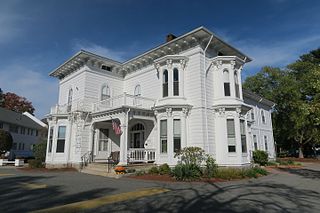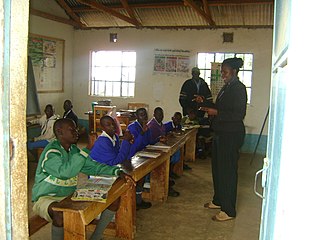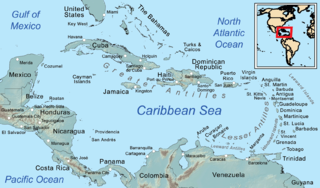
Deaf culture is the set of social beliefs, behaviors, art, literary traditions, history, values, and shared institutions of communities that are influenced by deafness and which use sign languages as the main means of communication. When used as a cultural label, especially within the culture, the word deaf is often written with a capital D and referred to as "big D Deaf" in speech and sign. When used as a label for the audiological condition, it is written with a lower case d. Carl G. Croneberg was among the first to discuss analogies between Deaf and hearing cultures in his appendices C and D of the 1965 Dictionary of American Sign Language.
Manually Coded English (MCE) is an umbrella term referring to a number of invented manual codes intended to visually represent the exact grammar and morphology of spoken English. Different codes of MCE vary in the levels of adherence to spoken English grammar, morphology, and syntax. MCE is typically used in conjunction with direct spoken English.

The Learning Center for the Deaf (TLC) is a Framingham, Massachusetts-based non-profit organization and school serving deaf and hard-of-hearing children and adults. The mission of The Learning Center for the Deaf is to ensure that all deaf and hard of hearing children and adults thrive by having the knowledge, opportunity and power to design the future of their choice.

The Children's Center for Communication/Beverly School for the Deaf (CCCBSD) is a school, established in 1876, for students from birth to age twenty-two who are Deaf, Hard-of-Hearing, or hearing with complex communication needs by providing language that is visually accessible via American Sign Language, written English, speech, and AAC/Assistive Technology.

Jane Fernandes is an American educator and social justice advocate. As of August 2021, Fernandes is the President of Antioch College in Yellow Springs, Ohio. She previously served as president of Guilford College from 2014 to 2021.

Rochester School for the Deaf (RSD) is a private, tuition-free school for deaf and hard of hearing students to attend in Rochester, New York. It is one of the oldest and most respected preK-12th grade schools for children with hearing loss and their families in the United States, and one of nine such school in the state of New York. Serving the Central and Western portions of New York State, it has been educating students since 1876.
Singapore Sign Language, or SgSL, is the native sign language used by the deaf and hard of hearing in Singapore, developed over six decades since the setting up of the first school for the Deaf in 1954. Since Singapore's independence in 1965, the Singapore deaf community has had to adapt to many linguistic changes. Today, the local deaf community recognises Singapore Sign Language (SgSL) as a reflection of Singapore's diverse culture. SgSL is influenced by Shanghainese Sign Language (SSL), American Sign Language (ASL), Signing Exact English (SEE-II) and locally developed signs.
The Vermont Center for the Deaf and Hard of Hearing, a non-profit organization, was the primary educational and support services resource for Deaf and Hard of Hearing residents in Vermont and surrounding areas. The Vermont Center, headquartered at Brattleboro’s Austin’s School For The Deaf, was launched by the Austine School in 1998 and operated until 2014. The Austine School was one of four independent schools and twelve outreach programs through which the Vermont Center assisted thousands of Deaf Vermonters.

Deaf education is the education of students with any degree of hearing loss or deafness. This may involve, but does not always, individually-planned, systematically-monitored teaching methods, adaptive materials, accessible settings, and other interventions designed to help students achieve a higher level of self-sufficiency and success in the school and community than they would achieve with a typical classroom education. There are different language modalities used in educational setting where students get varied communication methods. A number of countries focus on training teachers to teach deaf students with a variety of approaches and have organizations to support and advocate for deaf students.
The Deaf community over time has worked to improve the educational system for those who are Deaf and hard of hearing. The history of Deaf education dates back to ancient Egypt where the deaf were respected and revered. In contrast, those who were deaf in ancient Greece were considered a burden to society and put to death. The educational aspects of the deaf community has evolved tremendously and still continues to grow as the science of linguistics, educational research, new technologies, and laws, on local, national, and international levels are steadily being introduced. Strategies, however, remain controversial.
The history of deaf education in the United States began in the early 1800s when the Cobbs School of Virginia, an oral school, was established by William Bolling and John Braidwood, and the Connecticut Asylum for the Deaf and Dumb, a manual school, was established by Thomas Hopkins Gallaudet and Laurent Clerc. When the Cobbs School closed in 1816, the manual method, which used American Sign Language, became commonplace in deaf schools for most of the remainder of the century. In the late 1800s, schools began to use the oral method, which only allowed the use of speech, as opposed to the manual method previously in place. Students caught using sign language in oral programs were often punished. The oral method was used for many years until sign language instruction gradually began to come back into deaf education.

The Deaf rights movement encompasses a series of social movements within the disability rights and cultural diversity movements that encourages deaf and hard of hearing to push society to adopt a position of equal respect for them. Acknowledging that those who were Deaf or hard of hearing had rights to obtain the same things as those hearing lead this movement. Establishing an educational system to teach those with Deafness was one of the first accomplishments of this movement. Sign language, as well as cochlear implants, has also had an extensive impact on the Deaf community. These have all been aspects that have paved the way for those with Deafness, which began with the Deaf Rights movement.
HASA is a social benefit 501(c)(3) organization located in Baltimore, Maryland, that specializes in facilitating communication. Established in 1926, the organization provides special education services through Gateway School, audiology and speech-language services through its Clinical Services Department, and interpreting services for the deaf through its CIRS Interpreting Department.
ASL interpreting is the real-time translation between American Sign Language (ASL) and another language to allow communication between parties who do not share functional use of either language. Domains of practice include medical/mental health, legal, educational/vocational training, worship, and business settings. Interpretation may be performed consecutively, simultaneously or a combination of the two, by an individual, pair, or team of interpreters who employ various interpreting strategies. ASL interpretation has been overseen by the Registry of Interpreters for the Deaf since 1964.
Kendall Demonstration Elementary School (KDES) is a private day school serving deaf and hard of hearing students from birth through grade 8 on the campus of Gallaudet University in the Trinidad neighborhood of Washington, D.C. Alongside Model Secondary School for the Deaf, it is a federally funded, tuition-free demonstration school administered by the Laurent Clerc National Deaf Education Center at Gallaudet University.

Petra Fandrem Howard was an American deaf labor advocate. Hard of hearing from a young age, she was the first employee in the Minnesota Labor Bureau for the Deaf, created to support deaf workers and encourage employers to hire the deaf. Howard worked in vocational rehabilitation for the deaf for over forty years.
There are about 357,000 deaf and 3,210,000 hard-of-hearing people in Canada. The country can be split into Francophone and Anglophone regions, and has both French and English as official languages. The majority of Canada is considered Anglophone, while the province of Quebec along with small parts of New Brunswick, Ontario, and Manitoba are primarily French-speaking. The presence of these two main languages and cultures also brings forth different deaf cultures between the two regions. In Francophone regions, the official language used by deaf and hard-of-hearing people is Quebec Sign Language.
The Democratic Republic of the Congo has a population of about 1.4 million deaf people out of a total population of about 86.7 million. The World Health Organization (WHO) claims that countries in Sub-Saharan Africa are one of the more greatly affected regions by hard-of-hearing complications, compared to the rest of the world. Deaf people in the DRC are subject to neglect and discrimination by their families and the government, but they are also met with small, various ways of support and charity through international, European, Australian, and American religious, non-religious, and governmental organizations.

The Windward Islands are a group of islands in the Caribbean Sea that include Dominica, Martinique, Barbados, Saint Lucia, Saint Vincent and the Grenadines, Trinidad and Tobago, and Grenada. A variety of cultures, beliefs, languages, and views of deafness exist on the islands.
The Filipino Sign Language (FSL) is the official language of education for deaf Filipinos, which number around 121,000 as of 2000.









